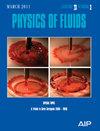On the active flow control in maglev train safety under crosswinds: Analysis of leeward suction and blowing action
IF 4.1
2区 工程技术
Q1 MECHANICS
引用次数: 0
Abstract
The design speed of high-speed maglev trains is much higher than that of wheel-rail trains, and they will be subject to more operational safety threats under complex wind conditions. The present study uses the improved delayed detached eddy simulation method based on the shear stress transfer k–ω turbulence model to explore the effect of active flow control on the aerodynamic lateral force of a maglev train and examines the main aerodynamic performance differences caused by two active control forms (suction and blowing airflow), involving multiple active flow speeds. In the current scenario, blowing can reduce the lateral force coefficient of the head car by up to 15% while greatly increasing its transient instability, which can be attributed to direct and indirect changes in pressure distribution near the air slots and a larger range of the leeward surface. The suction is believed to suppress the downstream motion of the main vortex on the leeward side of the maglev train and weaken the turbulent kinetic energy of the wake, while the blowing effect reduces the dominance of the main vortex. The application of blowing is proved as an effective means of reducing the risk of operating a maglev train in a crosswind environment, while it requires a careful consideration of both train safety and energy efficiency.关于横风下磁悬浮列车安全的主动流量控制:背风吸力和吹风作用分析
高速磁悬浮列车的设计速度远高于轮轨列车,在复杂风况下将面临更多的运行安全威胁。本研究采用基于剪应力传递 k-ω 湍流模型的改进型延迟脱离涡模拟方法,探讨了主动流控制对磁悬浮列车气动侧向力的影响,并研究了两种主动控制形式(吸入气流和吹入气流)造成的主要气动性能差异,涉及多种主动流速度。在当前情况下,吹气可使头车的侧向力系数降低 15%,同时大大增加其瞬态不稳定性,这可归因于气槽附近压力分布的直接和间接变化以及背风面更大范围的变化。吸力被认为抑制了磁悬浮列车背风面主涡旋的顺流运动,削弱了尾流的湍流动能,而吹风效应则降低了主涡旋的主导地位。事实证明,吹风的应用是降低磁悬浮列车在横风环境下运行风险的有效手段,同时需要仔细考虑列车安全和能源效率。
本文章由计算机程序翻译,如有差异,请以英文原文为准。
求助全文
约1分钟内获得全文
求助全文
来源期刊

Physics of Fluids
物理-力学
CiteScore
6.50
自引率
41.30%
发文量
2063
审稿时长
2.6 months
期刊介绍:
Physics of Fluids (PoF) is a preeminent journal devoted to publishing original theoretical, computational, and experimental contributions to the understanding of the dynamics of gases, liquids, and complex or multiphase fluids. Topics published in PoF are diverse and reflect the most important subjects in fluid dynamics, including, but not limited to:
-Acoustics
-Aerospace and aeronautical flow
-Astrophysical flow
-Biofluid mechanics
-Cavitation and cavitating flows
-Combustion flows
-Complex fluids
-Compressible flow
-Computational fluid dynamics
-Contact lines
-Continuum mechanics
-Convection
-Cryogenic flow
-Droplets
-Electrical and magnetic effects in fluid flow
-Foam, bubble, and film mechanics
-Flow control
-Flow instability and transition
-Flow orientation and anisotropy
-Flows with other transport phenomena
-Flows with complex boundary conditions
-Flow visualization
-Fluid mechanics
-Fluid physical properties
-Fluid–structure interactions
-Free surface flows
-Geophysical flow
-Interfacial flow
-Knudsen flow
-Laminar flow
-Liquid crystals
-Mathematics of fluids
-Micro- and nanofluid mechanics
-Mixing
-Molecular theory
-Nanofluidics
-Particulate, multiphase, and granular flow
-Processing flows
-Relativistic fluid mechanics
-Rotating flows
-Shock wave phenomena
-Soft matter
-Stratified flows
-Supercritical fluids
-Superfluidity
-Thermodynamics of flow systems
-Transonic flow
-Turbulent flow
-Viscous and non-Newtonian flow
-Viscoelasticity
-Vortex dynamics
-Waves
 求助内容:
求助内容: 应助结果提醒方式:
应助结果提醒方式:


